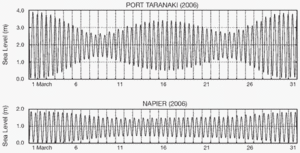All around the New Zealand coastline the tidal regime is semi-diurnal. This means that on most days two high and two low tides will occur at any given location. However, if the first tide for the day occurs after about 5:10 am there will be just three tides on that day. The fourth one in the sequence will take place very early the following day.
Maximum tidal ranges exceeding 3.5 metres occur at Onehunga, Port Taranaki, Nelson, Westport and Auckland. The smallest tidal ranges (2 metres or less) are experienced at Gisborne, Napier, Wellington and Picton.
The classic fortnightly spring/neap cycle is not seen at Napier, Wellington and Lyttelton. At these sites the solar tides are dominated by the lunar ones and the result is known as a perigean tide.
The following diagrams of predicted tide curves at Port Taranaki and Napier illustrate these range and frequency variations. Note that both the tide curves cover identical periods and are plotted at the same vertical scale.

The diurnal inequality, where successive high or low water heights are not the same, is also apparent in the diagrams. This phenomenon is particularly evident in the Port Taranaki example for high waters during the periods March 8 to 16 and 22 to 30.
The tidal bulge travels around New Zealand's coastline in an anti-clockwise direction. This is contrary to what is expected from the Coriolis effect in the southern hemisphere. Regions like New Zealand that are surrounded by amphidrome points experience a counter-rotating circulation.
This tidal bulge takes approximately 13 hours to travel around the North and South Islands. Therefore, at any one given time there is always a high tide (and a low tide) occurring somewhere around the coast. This pattern of flow is the reason why the state of the tides in Auckland's Waitemata and Manukau Harbours are never the same despite their close proximity. The tide has to travel from Auckland around Northland to reach the Manukau Harbour, a journey that takes about 3½ hours on average.
Since the moon is the principle force driving New Zealand's semi-diurnal tides, a complete tide cycle lasts on average 12 hours 25 minutes. Each incoming (flood) and outgoing (ebb) tide could, therefore, be expected to last about 6 hours 10 minutes. This is the case at most of the standard ports, with Dunedin and Picton being notable exceptions. At Dunedin the flood interval is consistently 30 minutes shorter, and the ebb tide correspondingly longer, than the nominal interval. At Picton the variation is more pronounced. The duration of the incoming tide has a range of 5½ to 9½ hours and ebb tides have a range of 4½ to 8½ hours. The longest durations are observed during the neap tides that occur 3 to 4 days after first quarter moon in February, March, August and September. This appears to be due to the effect that the sizes of the semi- and quarter-diurnal tidal constituents have on the relatively small neap tide range at Picton.
Cook Strait: Between the North and South Islands the tide travelling northward along the east coast passes the southbound tide on the west coast. The strong difference between the states of these tides, combined with the east/west tide height difference, produces the complex pattern of strong currents that flow through Cook Strait.